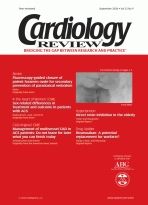Publication
Article
Cardiology Review® Online
Multivessel CAD in ACS patients: Four important implications
Author(s):
The article by Schwartzman and Brener (page 33) has 4 important implications for the treatment of acute coronary syndrome (ACS) patients who are found to have multivessel coronary artery disease (CAD) during diagnostic coronary angiography.
The article by Schwartzman and Brener has 4 important implications for the treatment of acute coronary syndrome (ACS) patients who are found to have multivessel coronary artery disease (CAD) during diagnostic coronary angiography.
The first implication relates to the choice of revascularization approach. We have shown in the CRUSADE quality improvement initiative that a shift in revascularization strategies for non—ST-segment occurred elevation (NSTE) ACS patients who have 3-vessel CAD occurred after the introduction of drug-eluting stents into US practice in 2003, with increasing use of multivessel percutaneous coronary intervention (PCI) and decreasing use of coronary artery bypass graft surgery.1 The CRUSADE analysis, however, was performed before the more recent controversy regarding the long-term risks of stent thrombosis after drug-eluting stent placement; thus, the approach to revascularization may have changed over the past year, especially for NSTE-ACS patients in whom use of drug-eluting stents during PCI would be considered “off-label.”2 Although a patient’s theoretical risk of stent thrombosis likely increases with placement of a greater number of drug-eluting stents, the risk of restenosis increases with placement of a greater number of bare metal stents (BMS). This conundrum complicates decision-making regarding appropriate revascularization in NSTE-ACS patients with multivessel CAD.
The second implication focuses on the acute risks of single-vessel versus multivessel PCI for NSTE-ACS patients. Schwartzman and Brener’s study did not show an increased risk of complications in patients undergoing multivessel PCI compared with those receiving single-vessel intervention, but the study included a highly selected population of patients who were not randomized to 1 PCI procedure over another; thus, definitive conclusions regarding the safety of multivessel versus single-vessel PCI cannot be made. Nevertheless, one can conclude that multivessel PCI for NSTE-ACS can be performed safely with proper patient selection by the interventionalist.
The third implication relates to the difficulties in determining the relative functional severity of non-culprit-vessel stenosis in NSTE-ACS patients. Presumably, the majority of patients with NSTE-ACS have a long-standing history of CAD that did not produce severe symptoms before an acute presentation, so the relative indications for revascularization for non-culprit-vessel stenosis is not clear and may be predicated solely on angiographic appearance rather than a detailed evaluation of a patient’s medical history. Periprocedural analyses, such as intravascular ultrasonography or fractional flow reserve measurements, are also infrequently used to assess non-culprit lesions. Further studies are needed to determine if angiographic assessment of lesion severity should be the dominant factor that guides decision-making for multivessel versus single-vessel PCI in NSTE-ACS patients.
The last implication, which is strongly emphasized at the end of the Schwartzman and Brener article, is that long-term studies are needed to more accurately evaluate the rates of ischemic events (eg, death, MI, stent thrombosis, and need for revascularization procedures) after multivessel versus single-vessel PCI. Such studies would serve to improve acute decision-making in the catheterization laboratory regarding optimal treatment in NSTE-ACS patients.
Until further studies become available, multivessel PCI in select NSTE-ACS patients with multivessel CAD appears reasonable for significant lesions (>75%) in nonculprit vessels; however, patients should have normal renal function, which allows for higher contrast loads during a single procedure, and a high ischemic burden. For now, the use of drug-eluting stents should be reserved for lesions with a high angiographic risk for restenosis, including cases of small vessel size, long lesion length, and in-stent restenosis.






